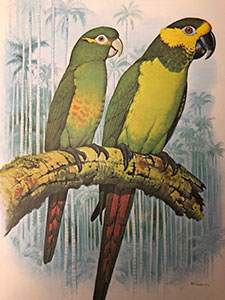Remembering the Life and Bravery of Conservationist Gonzalo Cardona
News Based on facts, either observed and verified directly by the reporter, or reported and verified from knowledgeable sources.
 By Bryan Kluepfel
By Bryan Kluepfel
As I head for another trip to South America, I’m reminded that just last year a leader in environmental conservation, Gonzalo Cardona, was killed in Valle del Cauca, Colombia. Gonzalo dedicated the last 23 years of his life to protecting the yellow-eared parrot, a wondrous bird which was in danger of extinction. (It has already been extirpated, or made locally extinct, in neighboring Ecuador.)
Colombia has become somewhat safer since the most terrifying days of the drug cartels. It has become a more popular birding destination. It could be the greatest birding destination on the planet, for its range of habitat and number of species.
Yet Colombia is still the most dangerous place in the world to take a stand for the environment.
In 2019, 64 park rangers and others working to protect and preserve nature were killed. There is ongoing conflict between remnants of the FARC, which signed a nominal peace treaty with the government in 2016, and the country’s official armed forces.
It was into this mess that “Gonza” Cardona bravely stepped. He had been a farmer, but he had no specific reason to protect an endangered species. He could have gone on with his life, as many of his fellow Colombians do every day. But he persisted.
When Gonzalo began counting the yellow-eared parrots in 1998, there were only about 80 left in Colombia. Through his efforts, and those of ProAves, a nonprofit conservation organization in Colombia, the number grew to more than 2,800 when he completed his last census in December 2020.

After last year’s census, on Jan. 8, Gonzalo was returning to Roncevalles, a mountain town 2,400 meters above sea level. His birthplace, Roncevalles is a town that has been occupied by armed forces, its citizens terrorized and killed. A place to tread lightly.
There is a road connecting Barragán and Roncesvalles. A lonely road, and a no-go zone after 6 p.m., “everyone knows,” said the local papers. FARC holdouts, armed bandits and others don’t like “their” territory compromised after dark. Gonzalo hopped on his motorbike and headed home for a well-deserved rest after completing the census.
He never made it.
A few days later, after his disappearance was reported and publicized, Gonzalo’s wife received a call from the perpetrators who shot and killed him. They can stop looking; you can find his body here, they said. The corpse was found, covered in sticks and dirt, with two bullets in the chest.
Gonzalo Cardona died defending a species of parrot that otherwise may have disappeared forever. He never questioned why he did it. It simply had to be done. He knew, and he persisted.
Gonza gave people hope. He made Colombians proud of their natural treasures, just as the adventurous team at Expedicion BIO from the Humboldt Institute is reclaiming this heritage and giving the country a path forward in conservation and eco-tourism. Gonzalo lives on in the work of ProAves throughout Colombia, and through the annual Yellow-Eared Parrot Festival in Roncevalles, close to where he died.
Dian Fossey, the American primatologist murdered in Rwanda on the day after Christmas in 1985, would have been proud to know Gonzalo. I’m sorry I never met him.
Today’s column is also dedicated to Franz Jägerstätter, a humble Austrian farmer who faced down terror, refusing to be conscripted into Hitler’s army or to sign an oath of loyalty to the Fuhrer. For this, he died, beheaded at age 36.
Much of this column originally appeared on the blogsite birdmanwalking.com.
Brian Kluepfel of Ossining is a proud member of Saw Mill River Audubon and an author for the Lonely Planet travel book series, Westchester Magazine and Birdwatching Magazine. His article on birding in Newfoundland appeared in October’s Birdwatching. Check him out at birdmanwalking.com.

Examiner Media – Keeping you informed with professionally-reported local news, features, and sports coverage.
